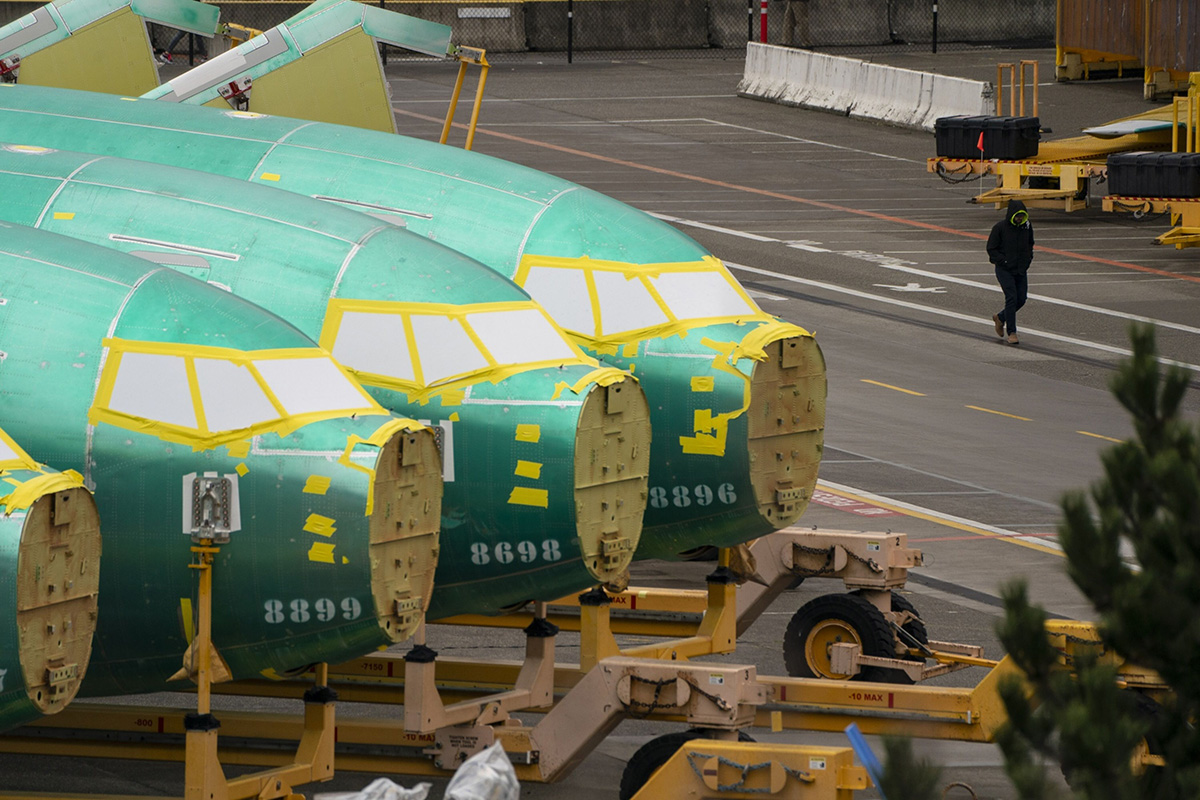 A worker walks near Boeing 737 fuselages outside the Boeing Co. manufacturing facility in Renton, Washington.
A worker walks near Boeing 737 fuselages outside the Boeing Co. manufacturing facility in Renton, Washington.
Boeing Co. predicted a massive cash drain for the first quarter as regulatory scrutiny and slower output of its 737 Max jetliner following a January midair accident take their toll on its finances.
Cash outflows will reach US$4 billion to $4.5 billion in the first quarter, Boeing CFO Brian West told a Bank of America conference in London on Wednesday. For the full year, free cash flow will be in the low-single-digit billions of dollars, West said. Analysts expected $5 billion, according to data compiled by Bloomberg.
Recommended For You
The outlook reflects a shift in priorities at Boeing as it grapples with the aftermath of a near-catastrophic fuselage failure on a 737 Max 9 aircraft early this year. The company has slowed jet deliveries as it pours resources into eradicating so-called 'traveled' work from across its commercial product lines, West said. The out-of-sequence installation of parts is at the heart of a quality breakdown that has spurred a painstaking review of its manufacturing by U.S. regulators.
"We're not at the moment where we can manage the near term for these financial outcomes because of the work at hand around stability," West said. "Our expectation is that we'll get more predictable and better-positioned, but it will take time."
West expects margins for Boeing's commercial aircraft business will be negative, to the tune of about 20 percent, in the first quarter—the company's worst performance since late 2021. While the losses should improve over subsequent months, margins should remain negative for 2024, he added.

Regulators have capped production of the 737—Boeing's largest source of cash—until they're satisfied the company has a firm grasp on the quality of work in its production system. West said production rates will be lower in the first half and then rise in the latter part of the year toward 38 737 Max planes each month. Anything beyond that "will be up to the FAA," West said, referring to the Federal Aviation Administration.
As of March 1, Boeing stopped accepting fuselages from Spirit AeroSystems Holdings Inc. that lack parts or require repairs, West said. While that should cut down on the workload for Boeing's mechanics, in the near term "there might be variability of supply," he said.
Boeing is set to report earnings for the first quarter in late April. Weeks after the January incident, Boeing declined to provide its usual annual target for 737 deliveries as it worked through fixing its processes and dealing with intensifying public scrutiny on its production standards.
The slowdown at Boeing is starting to be felt among airlines as they clamor for new jets. Ryanair Holdings Plc CEO Michael O'Leary said at a separate conference in Brussels on Wednesday that summer capacity in Europe will be held back by Boeing's delivery delays and separate engine issues afflicting Airbus SE aircraft. The Irish budget carrier flies an all-Boeing fleet and has been forced to scale back some targets and destinations for this summer because it's not getting the number of planes it had planned for.
Investor expectations have dimmed for what was supposed to be a crucial year in the manufacturer's recovery from a half decade of turmoil. Boeing's cash balance could dip into the $8 billion range by the end of the first quarter, after it pays off some debt at the start of the year, Seth Seifman, an analyst with JPMorgan, told clients. The company ended 2023 with about $16 billion of cash and short-term securities.
Despite the setbacks, Boeing has sufficient reserves to pay for a possible acquisition of Spirit Aero in cash and debt rather than issuing equity, West said. If it's consummated, the deal would reverse Boeing's largest outsourcing move after nearly 20 years, allowing the aerospace giant to tighten oversight of its most important parts provider.
FAA Administrator Michael Whitaker told NBC News on Tuesday that he walked away from a recent visit to the manufacturer's Seattle-area industrial base concerned that the emphasis on boosting production rates had eroded Boeing's safety culture.
Given the uncertainty around the FAA's actions on the 737, analyst Robert Stallard of Vertical Research Partners suggested that Boeing should ditch its precrisis goal of generating $10 billion in cash by 2025 or 2026 until it has made more progress on sorting out its problems.
West reaffirmed the target on Wednesday, while acknowledging the improvements won't come until later in the time period. "The first step toward fixing a problem is acknowledging that it exists," Stallard told clients. "Boeing's cut to its free cash flow guidance is an overdue recognition of the situation it is in, but we still worry that it is being overly optimistic."
© Touchpoint Markets, All Rights Reserved. Request academic re-use from www.copyright.com. All other uses, submit a request to [email protected]. For more inforrmation visit Asset & Logo Licensing.



